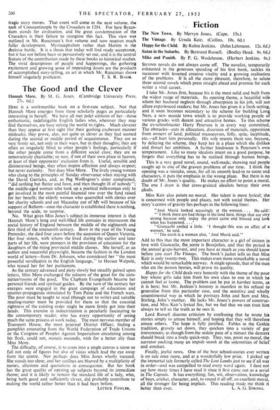TVvelfth-Century Crusades
WITH the second volume of his crusading trilogy Mr. Runciman securely establishes his right to retell an often-told story. The policies of the Near East are seldom easy to summarise. In the twelfth century several small Moslem States, between the more solidly established sultanates of Rum and Baghdad, were constantly changing hands and regrouping themselves in temporary alliances. Now one, now the other would gain in importance from the prestige of some leader or even from the lucky capture of some neighbohring chief. This shifting balance of power is the essential background to Crusad- ing history, and Mr. Runciman, with more space to describe it than was available for Stevenson in his pioneer work, has brought it to some semblance of life, though a map of wider extent than those provided would be.of considerable help to the reader.
The Crusading States have difficulties of their own for the narrator. The dramatis personae are very numerous, short-lived and bewilder- ingly inter-related. Reinforcements from the West constantly bring new figures upon the scene, who enjoy a brief prominence and then return home. Here Mr. Runciman writes with convincing familiarity and characters emerge sufficiently to stay in the reader's mind till their next appearance. In one place Eustace Of Boulogne inadvert- ently becomes Stephen, but it is a rare slip in a masterly handling of this unruly body of kings, princes, bishops, their ladies and their followers. In his preface Mr. Runciman writes that " the main theme in this volume is warfare ; and in dwelling on the many campaigns and raids I have followed the example of the old chroniclers who knew their businesi." It is indeed a grim and bloody chronicle.
For one chapter Mr. Runciman pauses to take stock of the situa- tion and to write a most illuminating section on the abiding problems of Westerners who settle in the East. He deals more briefly with legal and constitutional developments. Clearly these are matters that are of less interest to him, less, I think, than they were to the men of whom he writes, for whose legal knowledge and ingenuity - there is considerable evidence, though much of it comes from the following century. An account of the artistic and economic develop- ments is promised in the third volume, with the provocative state- ment that both" reached fuller importance in the thirteenth century." In the arts, the Church of the Holy Sepulchre, the mosaics of Beth- lehem, the manuscripts of the Jerusalem scriptorium, the carvings of the Temple area, seem serious challenges to this opinion, and Mr. Runciman's defence of it will be of much interest.
A more serious question is raised by Mr. Runciman's treatment, or rather absence of treatment, of the religious issues of the Crusad- ing movement. The chroniclers write continuously of battles and skirmishes, but they are also, Christian and Moslem alike, prone to expressions of piety. These, no doubt, are partly stylistic conven- tions of the time, but they reflect an accepted attitude of mind, which can hardly have lacked some genuine fervour behind it. In this " world's debate," Christianity and Islam are the two greatest protagonists, whatever the excesses in which their votaries became involved. It is exactly here that Mr. Runciman's detachment becomes most marked. He is never patronising, but he is aloof. He observes, but he never wishes to enter into, the emotions of the time. This is classical historical writing, not romantic, however much Mr. Runciman enjoys some of the incidents he narrates. -Occasionally his wit betrays him into too modern a touch, as when he allows the Cypriots to send food-parcels to Antioch or describes Amalric's vision of St. Bernard as one of the saint's " most unfor- tunate interventions into Crusading history."
The present volume has as its climax the capture of Jerusalem by Saladin, but it is not the loss of the Holy City nor the triumphant revival of the Jihad that is the ultimate event towards which the tragic story moves. That event will come in the next volume, the sack of Constantinople by the Crusaders in 1204. For here Byzan- tium stands for civilisation, and the great condemnation of the Crusaders is their failure to recognise this fact. This view was outlined in Mr. Runciman's first volume and now receives much fuller development. Myriocephalum rather than Hattim is the decisive battle. It is a thesis that today will find ready acceptance, but it has not before been so persuasively set out, and it is the central feature of the contribution made by these books to historical studies. The vivid descriptions of people and happenings, the gathering excitement and growing sense of impending doom are the products of accomplished story-telling, an art in which Mr. Runciman shows



































 Previous page
Previous page